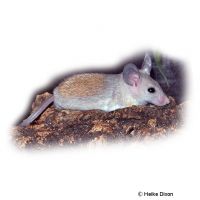Eastern Spiny Mouse (Acomys dimidiatus)
| Eastern Spiny Mouse Acomys dimidiatus | |
|---|---|
| Name | Eastern Spiny Mouse |
| Name Lat. | Acomys dimidiatus |
| Family | Murids |
| Family lat. | Muridae |
| Order | Rodents |
| Order lat. | Rodentia |
| Origin | Africa, Asia |
| Climate | Subtropical - tropical |
| Habitat | Semi-desert, savanna |
| Diet | Seeds, plant matter, insects |
| Behavior | Nocturnal |
| Keeping | Pair, group |
| Care Level | Moderate |
| Life Span | 2-4 years |
| Protection | No |
| Metric Units | |
| Size | 9-13 cm |
| Temperature | 22-26 °C |
| Housing | A: 0.5 m² / H: 50-60 cm |
| US Units | |
| Size | 3.5"-5.1" |
| Temperature | 72-79 °F |
| Housing | 5 ft² / 20" hight |
Distribution and habitat
Predominantly crepuscular to nocturnal, Sinai spiny mice are distributed from Western Sahara and Egypt to Iran and Pakistan. They live in rocky semi-deserts, deserts and savannas, where they inhabit rock crevices or abandoned burrows of other rodents, as they do not dig their own burrows.
Maintenance
Minimum dimensions for the enclosure:
| 1-2 animals | area: 0,5 m² | height: 50-60 cm |
For each additional adult animal the area has to be increased by 20 %. A terrarium placed in a bright (no direct sunlight), draught-free and quiet place is recommended, with ventilation openings on the sides, and it must not be tightly closed at the top.
They need climbing and hiding places, such as cork tubes, caves, roots, branches, stones, etc. and sleeping houses, as well as food bowls and a drinking vessel. Suitable substrate is, for example, small animal litter or a peat and sand mixture covered with some bark mulch or dry leaves. The substrate must always be kept dry. Furthermore, they need nail material, such as rodent stones and unsprayed branches of fruit trees, maple, etc., which should be available at all times.
| Temp. day: 22-26 °C | Temp. night: 18-20 °C | Temp. local: 30 °C |
Light sources that also produce the necessary heat are ideal. A natural day-night rhythm must be ensured.
Diet
Their diet is mainly vegetarian, but they also need animal protein. The diet consists of hay and a low-fat seed/grain mixture, available from specialist retailers as dwarf and golden hamster food or a mixture of both, as well as cob millet, which also serves to keep them occupied, supplemented with fresh food, such as root vegetables, lettuce, wild herbs and grasses, plus animal protein, such as live or dried insects (crickets, house crickets, etc.) and egg food. Carrots and fruit should be offered only in very small amounts because of their sugar content. Although they meet their fluid requirements primarily from food and drink very little, drinking water must always be available in a nipple drinker or open stable container and, like food, should be offered fresh daily
A varied diet promotes health and prevents deficiency symptoms.
Behaviour and compatibility
They are social and sociable animals and should be kept at least in pairs, but better in a family group (no single keeping). Strange animals are usually not accepted. A group should consist of fewer males and more females (harem). There can be fierce territorial fights between unneutered males. At the first signs of incompatibility, the animals should be separated immediately.
Reproduction and breeding
In males, the distance between the anus and the urethral opening is greater than in females
The gestation period is very long and is 35-42 days. A litter consists of 2-3 young, which are born completely hairy and with open eyes and leave the nest already after 2 to 4 days (nest fugitives). After 1 to 2 weeks, the animals are independent and sexually mature at 2-3 months. Spiny mice often exhibit nurse behavior by assisting other females in giving birth and rearing their young. The average life expectancy is 4 years.
Important
In the literature, the Sinai spiny mouse is usually seen as a variant of the Egyptian spiny mouse.
Local warm places are readily accepted (radiant heaters) and contribute to the well-being of the animals. They have spine-like hairs on a limited area on their back, hence the name.
As escape animals, they require adequate retreat and hiding places. They must not be grabbed or pulled by the tail, as the skin can easily tear and peel off. Care must be taken to ensure thorough hygiene and contamination must be removed regularly.
Further literature can be found in your pet store
References
Text: petdata; Image: Heike Dixon
Source: BMEL (2014): Gutachten über Mindestanforderungen an die Haltung von Säugetieren; W. PUSCHMANN, D. ZSCHEILE, K. ZSCHEILE (2009): Zootierhaltung - Tiere in menschlicher Obhut: Säugetiere, Harri Deutsch Verlag; GRZIMEK (2000): Grzimeks Tierleben Bd. 2 Säugertiere, Kindler Verlag
- Gemäß § 21 Abs. 5 Tierschutzgesetz idgF
